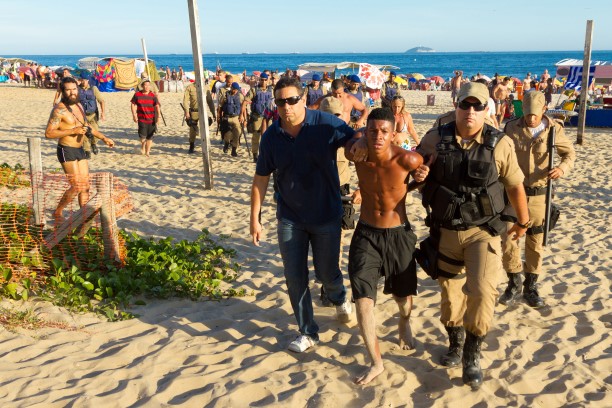Even though the city currently attracts a great number of visitors, Rio de Janeiro’s hoteliers and pub and restaurant owners are concerned about the recent levels of violence against tourists. Safety is one of the main factors for potential visitors to consider when choosing their holiday destinations.
Lapa, one of the favorite destinations among those who visit Rio, is a neighborhood that registered the highest number of phone robberies in the first three months of 2017 (121), in addition to ranking second in pedestrian robberies during the same period, with 458 occurrences. At the beginning of May, a group of 19 tourists was mugged when trying to cross the trail of Parque Large towards Christ the Redeemer.
In December 2016, before the Police strike in Rio, data released by the Public Safety Institute (ISP) revealed that the number of pedestrian robberies registered in the capital’s police stations increased 19.8%, compared to the same period in 2015. Across the whole state, that increase was even higher: 35.7%. Also in the capital, phone robberies rose 50.5% during this period, and 63.2% in the entire state.
Adding to that, the deaths of the Italian Roberto Bardella, which took place in December last year, the Argentinian Natália Capetti, in March this year – both shot dead when they mistakenly entered Morro dos Prazeres, in Santa Teresa – and the Argentinian Matias Sebastian Carena, beaten by a Brazilian outside of a bar, are a good reason for local hotel, pub and restaurant owners to worry, since such crimes represent a far greater threat to tourism than robberies and thefts.
According to the Ministry of Tourism, more than 1.48 million foreigners arrived in Rio in 2016, an increase of 7.5% compared to 2015. Additionally, more than 1.1 million tourists visited Rio just for the 2017 carnival, the highest number in the last eight years.
Less than a year after the end of the Olympic Games, tourism businesses are concerned that the robberies and other cases of violence against tourists in some of the neighborhoods may have a negative effect on the number of foreign visitors coming Rio.

The president of the Brazilian Hotel Industry Association of Rio de Janeiro (ABIH-RJ), Alfredo Lopes, believes that the deaths of Roberto Bardella and Natália Capetite could have been circumvented if there was a clear signaling system warning against the entrance in the city’s dangerous areas, particularly in territories controlled by drug traffickers. He emphasizes that violence does not actually affect everyone in Rio, but he acknowledges that tourists may end up choosing other cities and countries if they do not deem Rio as a safe destination.
“The state is bankrupt, which further exacerbates the safety issue. If a tourist does not feel safe in the city, he will choose other destinations. We have yet to be affected by booking cancellations, but there is obviously a concern, particularly focused on mid-year vacations, for instance, a period during which the South American market is our main target,” Lopes stated.
Indeed, the South American market is accountable for an essential portion of Rio’s tourism, impelling as well the rest of the country. Among Brazil’s five top tourist source countries, four are located in South America. In addition to Argentina, the nations of Paraguay, Chile and Uruguay hold the third, fourth and fifth positions, respectively, when taking into account the number of foreigners in the country.
When summed, those four countries represent 48.76% of the more than 6.5 million foreigners who visited Brazil in 2016. The United States have the first place, accounting for 8.67% (more than 570 thousand tourists).
The assessment of Alfredo Lopes also considers that some safety measures can be solved rather easily, such as marking the access routes that lead to dangerous areas.
“Having two tourists shot down simply because they turned the wrong way in a specific area is preposterous. This marking issue can easily be solved. Nevertheless, what one really needs is to take the city’s safety as a whole, because if the entire population feels safe, then the tourist will do as well,” he stressed.
The president of the Union of Rio’s Bars and Restaurants (SindRio), Pedro de Lamare, has a similar a view on the issue. For him, violence against tourists is not only something that takes its toll on the number of visitors, but is also something that affects the movement of the local people at nighttime. He advocates that bars and restaurants located in the most isolated streets are the first ones to feel the negative consequences.
“The circulation happens to be less affected in streets where there are several bars and restaurants, but businesses located in less-crowded streets have been struggling for a long time now with this negative shift in movement. Not only that, violence also fosters a crisis of undersupply in restaurants, given the constant thefts of cargo that take place on the roads,” he said.
In Santa Teresa, the spot where the murders of Robert Bardella and Natalia Capetti took place, violence has been a reason for complaints from residents since the beginning of 2016. Given this increase in robberies, which mainly affects tourists and visitors from other regions of the city and state, the neighborhood residents came together, alongside the Association of Residents and Friends of Santa Teresa (Amast), to disseminate posters across the streets, raising awareness for the risks of being robbed. The material points out the locations where residents and tourists have already been mugged before, even including texts written in English, French, Spanish, German and Italian.
Greetings from Rio! Unfortunately the violence in Rio is quite real, for tourists as well as for the locals. This situation is aggravated by the financial crisis that is happening in Brazil and especially in Rio de Janeiro. We like to receive tourists and we know the importance of this in our city, but in general, people in Rio are very concerned about their safety...